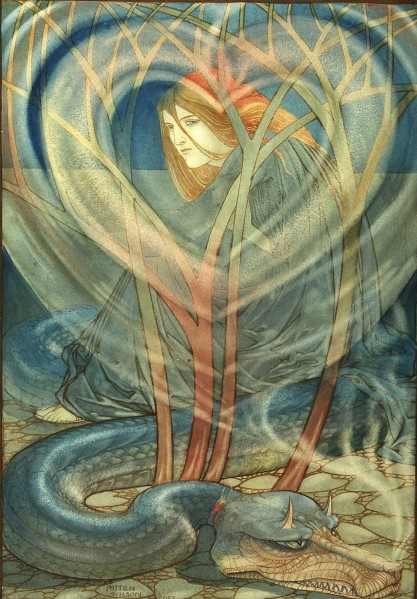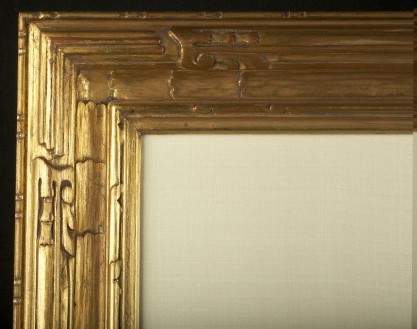

Patten Wilson, the British Art Nouveau illustrator and fine artist created this immaculately detailed and haunting watercolor on paper for use as frieze panel decoration for a high end wallpaper company. At the turn of the 20th century, lavishly decorated Victorian homes would feature rooms filled with fine art wall-coverings that recalled the symbolist mural imagery that graced public spaces. This haunting example was titled by the artist Deceit and shows a maiden in a shadowy forlorn woods with a serpent at her feet as she recalls the events which broke her heart. Reminding the viewer of the value placed on chastity for Victorian women, the watercolor acts as a “wages of sin” style parable, while incorporating stylized Art Nouveau harmonious elements through its sinuous curves and evocation of the natural world.
This is silk matted and framed in an ornate museum quality gold carved basswood frame.





Patten Wilson (1869 – 1934) was a British magazine and book illustrator.
Patten Wilson, the son of a clergyman, was born on March 23, 1869, in Shropshire. His brother was the architect and designer Henry Wilson (1864-1934), who ran an extensive business as a sculptor and metalworker, as well as taught metalwork at the Royal College of Art and at the Central School of Arts and Crafts in London.
At age 19, Wilson dropped out of Kidderminster School of Art, and returned home to pursue a course of self-education, studying the work of Albrecht Dürer (1471-1528). In addition, he made studies of animals and plants. His early designs were “spirited and full of invention”.[1] Taking a number of jobs, including secretary to the managing director of the Liverpool gymnasium, he continued his artistic endeavors. His earliest published drawings appeared in the magazine Recreation.
In 1894 Wilson was introduced to the publisher John Lane, who gave him a commission to design and illustrate Miracle Plays by Katherine Tynan Hinkson in a series of black-and-white line drawings. Subsequently he was invited as a contributor to the newly launched “The Yellow Book’, which ultimately published thirteen of his drawings. His first contribution, titled “Rustem Firing the First Shot”, appeared in January 1895, Volume 4, and was inspired by a prose translation of the original epic poem, Rustem and Sohrab by Matthew Arnold. He contributed two more illustrations to the poem in later volumes. Between 1895 and 1897, Wilson also provided title-illustrations for a number of volumes published by The Bodley Head. He contributed an Arthurian illustration to The Builder Magazine in 1896 and several illustrations to The Architectural Review in 1898. That same year, he was commissioned to provide illustrations for a volume of poetry by Samuel Taylor Coleridge. In 1901 he was asked by J. M. Dent to create twenty illustrations for The Gospel Story of Jesus Christ, along with three other books for that publisher, including another one hundred illustrations for A Child’s History of England by Charles Dickens. After 1905, he abandoned line drawings in favour of colour and half-tone, and moved into the fields of natural history and mythology.
